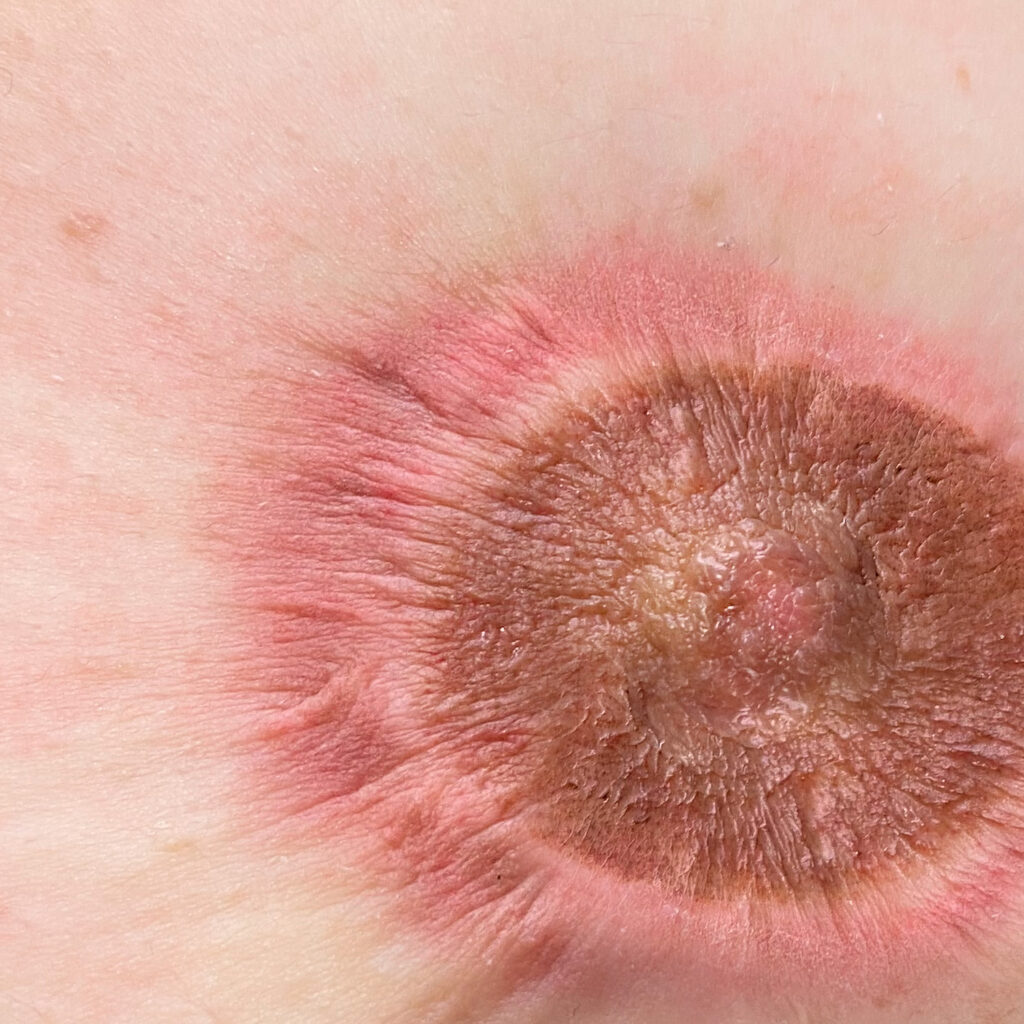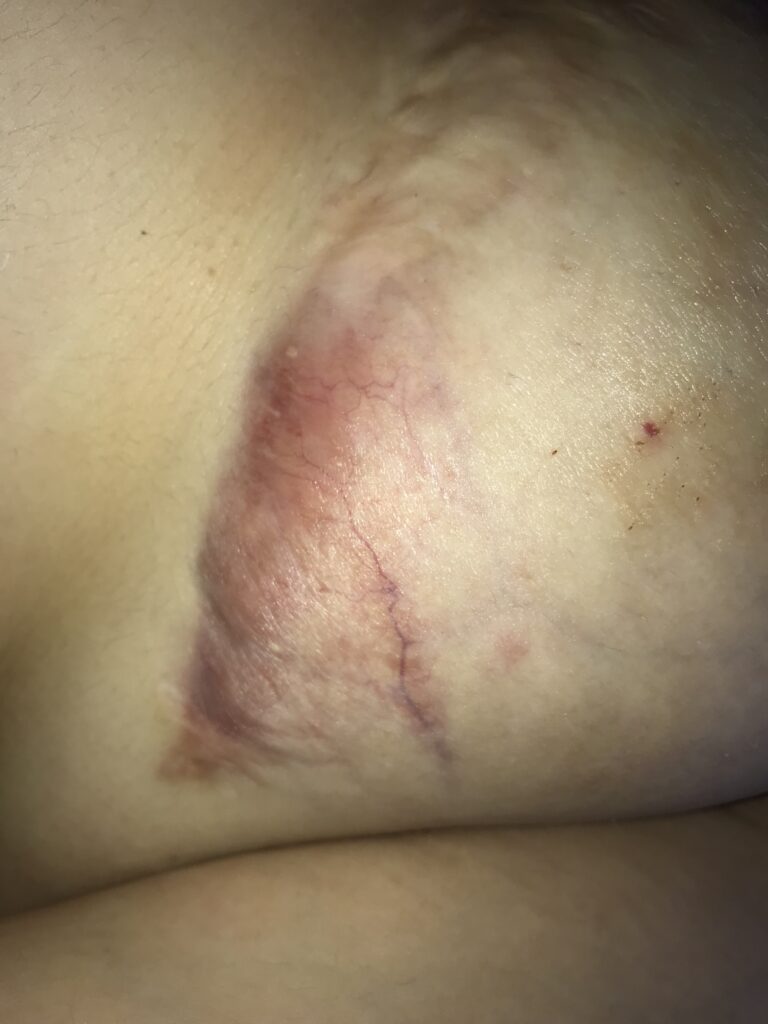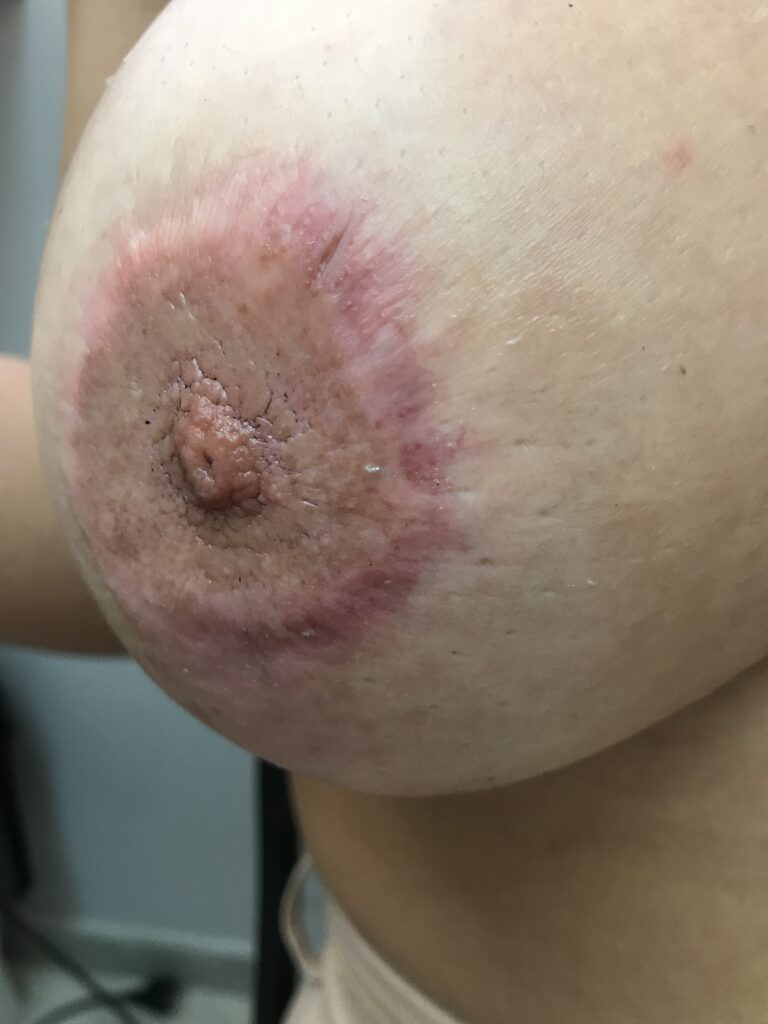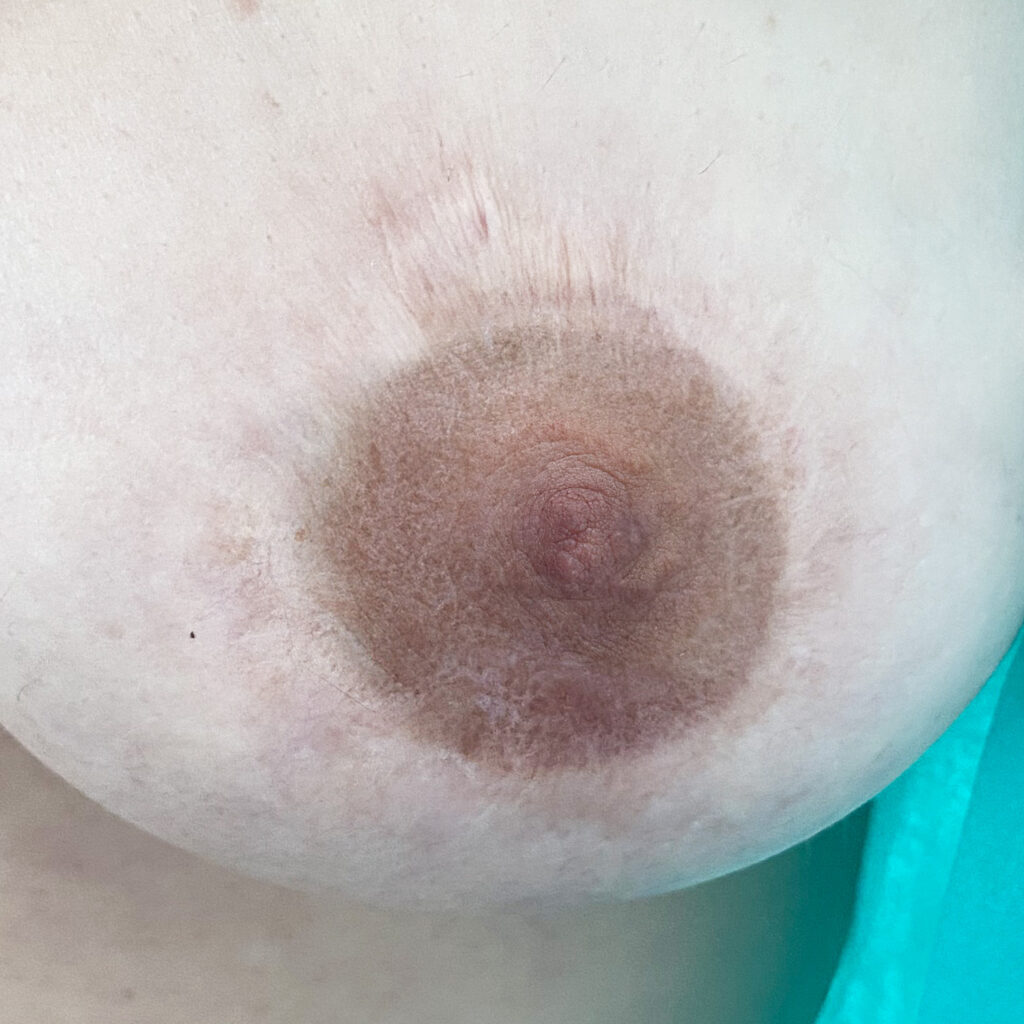Preparation for AREOLA DERMOPIGMENTATION procedure
Preparation for AREOLA DERMOPIGMENTATION procedure requires careful diagnosis of the postoperative area. Examination of the areola is recommended to be conducted in the first half of the day.
Low self-esteem among clients may be caused by congenital or acquired breast defects.
Many imperfections of the areola can be addressed with plastic surgery. I have written about this earlier. Nowadays, advanced technology allows fixing any flaws on the breast using areola dermopigmentation. This procedure is also called medical tattooing.This is a popular direction in permanent makeup. Unfortunately, not all specialists are professionally trained. You may see a lot of advertising online, with different prices for procedures. Many websites claim that it is a very simple procedure. You may also come across low prices for dermopigmentation procedures.
Let me be honest: the process of areola dermopigmentation is complicated. Achieving the perfect nipple may take more than one session. If a clinic charges less, the outcome might not be good. Some people may think, “Since the areola isn’t visible, why does the result matter?” It’s not right for a specialist to think this way. Every client deserves respect and care. Helping those in need is important to me.
Areola dermopigmentation is an art form
Dermopigmentation of the areola can only be applied to a fully healed breast after surgery. This is typically when the scars around the nipple and longitudinal scars have turned white.
In my practice, I closely observe my clients for extended periods. I want to emphasize the following: the surgeon performs their role. The skin heals after the operation, and scar formation is unique to each individual.
The surgeon’s responsibility does not extend to the recovery process; their role is limited to observation and providing recommendations. Typically, clients sign a surgical consent form and may undergo periodic monitoring at the clinic.
Skin recovery is always a complex process.
I always care for my clients and provide them with remote support. Unfortunately, not all specialists show careful attention to the client after the operation. Sometimes, the correct post-operative care is not prescribed for the client. If you have undergone surgery, you can consult with me afterward.
Complications After Surgery
After surgery, it is important to wear special garments. It is recommended to use special anti-inflammatory creams. Initially, the suture after surgery may be firm, but the firmness should gradually diminish.
Redness of the suture after breast surgery
Stitches inside the breast and near the nipple typically take 6 to 9 months to heal after surgery. Using certain products like anti-inflammatory creams can make this healing process faster.
If there are any hard lumps in the stitches after 2 months, it’s a good idea to see a doctor. Getting help early can help maintain the appearance of the breast.
Redness around the nipple after surgery
Dermopigmentation is often regarded as a minimally invasive technique, involving the injection of pigment into the skin to a depth of 0.5 mm.
The reddish hue surrounding the nipple can be addressed using a gentle dermopigmentation approach post-surgery, typically after 5-6 months or later. It’s important for my clients to grasp the essence of dermopigmentation.
For instance, if there are pale stitches surrounding the nipple but some slight redness persists, a subtle dermopigmentation procedure can be applied to this area.
When performing dermopigmentation beyond the nipple region, it’s crucial not to go too deep. This is because if dermopigmentation is undertaken a year or two following surgery, the area surrounding the nipple may no longer retain its pinkish color. Hence, the application of pigment should be kept light. It’s vital to ensure clients understand this concept, as additional pigment may be needed in this area (beyond the areola – where the redness occurs) after a year.
Dermopigmentation of the red area around the nipple
Areola dermopigmentation can only be performed on a fully healed breast after surgery. This typically occurs when the scars around the nipple and longitudinal scars have turned white.
In my practice, I closely monitor my clients for an extended period. I want to emphasize the following: the surgeon performs their job, and the skin heals after the operation, forming a scar that is unique to each individual. The surgeon is not responsible for the recovery process; they can only observe and provide recommendations.
Usually, the client signs a surgery agreement and periodically visits the clinic for observation. Skin recovery is always a complex process.
I always take care of my clients and provide them with remote support. Unfortunately, not all specialists pay adequate attention to the client after the operation, and the proper care is not always prescribed. If you have undergone surgery, you can consult with me afterward.
Complications after surgery
After surgery, it is important to wear special garments and use anti-inflammatory creams. Initially, the surgical scar may be slightly firm, but this effect should gradually diminish.
Redness of the surgical scar after breast surgery
Internal stitches after breast surgery and around the nipple area heal within 6 to 9 months. This process can be accelerated by using special products and anti-inflammatory creams.
If there are any complications such as thickening of the scar after 2 months, it is advisable to consult a doctor. Timely consultation can help preserve the aesthetics of the breast.
Redness around the nipple after surgery
The dermopigmentation procedure is considered one of the least traumatic techniques. Pigment is injected into the skin to a depth of 0.5 mm.
The red area around the nipple can be corrected with a light dermopigmentation technique after surgery, but not earlier than 5-6 months, and sometimes even later. I want my clients to understand this process.
For example, if there are white stitches around the nipple but there is slight redness around the nipple, a light dermopigmentation can be performed in this area.
Dermopigmentation beyond the nipple area should not be deep. If dermopigmentation is performed a year or two after surgery, the area around the nipple may no longer be pink. Therefore, the area of dermopigmentation should be as light as possible. It is important to explain this to the client because after a year, this area may require additional pigment.
Dermopigmentation of the red area around the nipple
Here’s an example from practice. Very often, women face issues with different nipples after surgery, as well as different breast sizes. I want to emphasize that everything in our body is unique. Many clients desire identical makeup, but it’s not always possible, just like with nipples. Areola dermopigmentation helps achieve the perfect breast, giving inner confidence to every woman.
Even after breast lifting, reduction, or augmentation, breasts may be slightly different. However, with dermopigmentation, I can visually correct the nipples so that a woman can comfortably visit saunas without clothes. Having a beautiful open chest is important. My clients claim that their husbands think their breasts are perfect. This is all thanks to dermopigmentation. All men perceive my work as the natural beauty of a woman. However, achieving the desired result often requires at least two sessions. Sometimes more sessions are necessary, depending on the complexity of the task and the goal shared by both the master and the client.
Here’s an example. At the 6-month mark after the breast surgery, I performed dermopigmentation for a client.
I aligned the nipples, concealed the scars (I did only one procedure). I easily disguised the pink area. It was the sixth month after the operation.
I did this dermopigmentation for the client so that the woman could comfortably go to the sauna without underwear.
AREOLA DERMOPIGMENTATION

Is it normal to have different breasts and redness after surgery?
One hundred percent perfect breasts are unattainable. Breasts cannot be perfectly symmetrical and smooth. There are always imperfections after surgery, and this should be accepted as normal.
Redness around the scar after surgery causes concern for patients. Everyone wants to know when the redness will disappear.
Surgical intervention always leaves traces. After breast surgery (mastoplasty), it’s normal to form a scar that may go through several stages of healing.
Redness around the scar in the areola area is a result of the body’s inflammatory response to damaged tissues. The skin in this area immediately after surgery typically has a pinkish-red hue. Usually, the redness peaks two weeks after the surgical procedure. Then the client observes a pink color.
When does the redness under the areola go away?
When does the redness go away after surgery? It all depends on the individual characteristics of each patient’s body and the complexity of the procedure. Post-operative care is also crucial.
Usually, the skin starts to acquire a more normal shade three months after surgery if the client uses additional skin recovery products. This area is constantly treated with scar-reducing creams.
Redness may persist for up to a year and sometimes up to 2 years.
However, for some patients, redness may persist longer. If the red skin around the scar does not subside after three months and there are significant hardenings in this area that are painful to the touch, it is urgent to consult a plastic surgeon for evaluation and assessment of the condition.


In such cases, the doctor may recommend additional treatment methods such as antibacterial and anti-inflammatory ointments to help accelerate the healing process and reduce the intensity of redness. Laser procedures may also be considered as an option.
It’s important to remember that each body is unique, and the healing time for each patient is individual.
An infected stitch is a serious issue that can occur after surgical intervention. It typically manifests as redness, swelling, pain, and may be accompanied by pus discharge. The inflammatory process around the stitch can be caused by various factors such as inadequate hygiene, infection during surgery, as well as individual body characteristics.
Important to know. Preparation for AREOLA DERMOPIGMENTATION
In case of a stitch inflammation, it’s important to seek immediate medical attention for appropriate treatment. This may include the use of antibiotics, anti-inflammatory drugs, as well as draining the infected area. It’s crucial not to attempt self-treatment for stitch inflammation, as it may worsen the problem and spread the infection.
In addition to treatment, it’s important to follow the doctor’s recommendations for wound care and surgical area management to prevent further infection development and ensure successful healing.
Changes in scar tissue around the nipple
If there are any concerns or unusual changes in the healing of the scar tissue, it is important to promptly consult a plastic surgeon for additional evaluation and assessment of the condition.
Causes of breast changes after surgery
Issues with hormonal balance, improper body positioning leading to poor posture, ill-fitting corrective undergarments, genetic predispositions, and individual body characteristics can contribute to changes in the breasts after surgery.
Sagging and drooping of the breasts are very common before menopause. However, it’s not something to worry about. Often, women undergo breast lift surgery, but the breasts still sag. This often occurs as a woman transitions through menopause. I often perform nipple dermopigmentation after surgery and frequently notice this characteristic in women.
Breast proportions may become uneven if hormones are deficient or in excess. If there is an imbalance, it’s advisable to consult an endocrinologist or mammologist. It’s also important to understand how deep stitches are placed in the breast.
Mastopathy (fibrocystic mastopathy) is a benign breast tumor. A characteristic symptom of mastopathy is palpable thickening in the breast. The main cause is hormonal imbalance. All types of mastopathy lead to noticeable asymmetry.
Women who participate in basketball, volleyball, and other sports where there is a risk of sudden arm elevation are at risk after surgery.
If there are any concerns or unusual changes related to complex healing processes or changes in the appearance of the breast after surgery, it’s always important to consult a specialist for further evaluation and, if necessary, treatment.
Correction of areolar asymmetry. Preparation for AREOLA DERMOPIGMENTATION
I perform correction of areolar asymmetry using dermopigmentation when the asymmetry is visible to the naked eye. This manifests in the shape and volume of the areola after surgery.
It’s worth noting that there is no perfect way to eliminate areolar asymmetry. Therefore, in this matter, it’s important to rely solely on the experience of the chosen specialist. It’s important for the specialist to have a creative taste and to perform the work responsibly.
Prevention of asymmetry
- Wear a corrective bra to prevent breast sagging after surgery.
- Take contrast showers to improve blood circulation.
- Proper physical exercises will strengthen posture and chest muscles.
Exercises should be recommended by a doctor.
Additional Questions – Preparation for Areola Dermopigmentation
When does the redness around the areola and scar fade?
Several weeks after breast plastic surgery, the scar may feel firm, tight, raised, or bumpy. This should be approached very carefully! Close observation by a surgeon is very important! Over time, the scar will become softer, smoother, and less red. Scar healing after surgery can take 12-18 months (12-18 months may still show pink color).
By the 6th month, very delicate dermopigmentation can be done. However, in the area of dermopigmentation on pink skin color, the redness may not completely disappear, but it will diminish. In this case, it’s important to highlight and even out the scar area. Highlight the areola, and as for the broad pink color behind the areola – delicately lighten it with pigment. After a year, additional pigmentation may be needed, if necessary.
Care must continue beyond the areola.
Why does the scar around the nipples remain red or pink for a long time?
During the process of collagen growth and increase in quantity, blood capillaries also increase in number. Hence, the client sees redness.
If dermopigmentation is done in this area, it should be done very delicately. It’s important to do it in such a way that additional pigmentation can be done in this area after a year.
In the final stage of scar healing after surgery, excess collagen breaks down, and the number of capillaries decreases. This can happen after 12-18 months. At this time, in some cases, breast pigmentation can be done.
How to tell if the stitch around the areola is inflamed?
If there are any lumps inside, fluid or pus is discharged from the wound, severe pain, swelling, and redness occur around the stitch area, along with a fever. Then antibiotics are needed.
How long does it take for a stitch to heal after breast surgery?
The longest healing time is for stitches after an anchor breast lift. In this case, the recovery period lasts 4-6 months. For periareolar and vertical mastopexy, the rehabilitation period ranges from 2 to 5 months.
When will the breast fully recover?
Pain usually subsides on the 5th-12th day after surgery, and swelling subsides within 2 weeks. Complete recovery may take 6-12 months.
It’s advisable to do dermopigmentation no earlier than the 5th month. In complex cases with clients, the area for dermopigmentation should be prepared for easier acceptance of the pigment by the skin.
Consultations for clients and specialists are provided on a paid basis, with exceptions for complex cases and clients after mastectomy.
Gradual Return to Normal Life
You can take a shower a week after breast augmentation surgery, but only with the doctor’s permission. Baths, swimming pools, saunas, and steam rooms are not recommended for 2-3 months.
Compression garments must be worn constantly for at least a month, including during sleep. Such clothing is necessary for proper breast fixation. Airplane travel can be planned after 2-3 weeks.
After areola dermopigmentation, returning to normal life and sexual activity can be done within three days. Restrictions may apply in special cases.
For example, for complex procedures involving complex scars, restrictions for the client may last up to 14 weeks, until the first scabs fall off.
Restrictions for sauna and swimming pool use after dermopigmentation may be 10-14 days, and very rare cases may have restrictions up to a month. With modern technologies and new pigments, most cases have short post-procedure restrictions.
Sports After Dermopigmentation
Two months after surgery, you can resume sports activities, but with gentle loads.
The timing of lifting restrictions depends on the individual characteristics of the patient, the speed of rehabilitation, and the specific types of sports. Strength training (intense cardio workouts, strength exercises) may be possible no earlier than six months after breast augmentation.
Sports after dermopigmentation can start immediately after 3 days, but intensity should be limited. After 10-14 days, you can train at your usual pace.
Preparation for AREOLA DERMOPIGMENTATION
Contraindications for Areola Dermopigmentation
Contraindications for performing areola dermopigmentation include:
Acute inflammatory process or infections in the nipple area.
Skin diseases or skin infections in the treated area.
Presence of skin cancer or other neoplastic changes in the nipple area.
Pregnancy or breastfeeding, as hormonal changes can affect pigmentation.
Allergy to pigment dyes or other materials used (tests are conducted before the procedure, but allergies are very rare; currently, pigments are developed in a way that allergic reactions are almost excluded).
Insufficient healing after previous surgery or injury in the nipple area.
Use of medications affecting blood clotting, as this may increase the risk of bleeding during the procedure.
Before performing dermopigmentation of the wart, it is important
Before performing areola dermopigmentation, it is important to conduct a thorough medical examination. The contraindications for dermopigmentation can be discussed individually during the consultation with the client.
The client’s psychological state and awareness of the procedure are also crucial for conducting areola dermopigmentation.
I am not a miracle worker, but my work improves the appearance of women’s breasts. Each case of dermopigmentation is analyzed individually.
I do not promise perfect results after one treatment. Areola dermopigmentation is a complex procedure that usually requires at least two sessions to achieve the desired outcome.
Individual preparation is provided for each client. Proper preparation of the client influences the quality of dermopigmentation.
Post-procedure care affects the quality of dermopigmentation. For some clients, I provide special post-procedure skincare products. These products are applied at various stages of the skin regeneration process. Each case is treated individually.
Do not be afraid of areola dermopigmentation. Trust me. I provide individual information about areola dermopigmentation to each client. Every case is different. I help all women. I restore beauty. You can fully trust me, and I will make your breast perfect. Unfortunately, I cannot publish all areola photos publicly. It’s the client’s privacy. I respect each client and take care of them individually.
If you have any questions, please write a comment under the article.
For areola dermopigmentation, I accept clients in Poland, in Wroclaw. You can contact me via private message or email at: AD@millecenta.com, millecenta@icloud.com.
The most important aspects to know when preparing for areola dermopigmentation are
- Consultation: It’s crucial to have a consultation with a qualified professional to discuss your goals, medical history, and any concerns you may have.
- Health Check: Ensure you are in good health and inform the technician about any medical conditions, allergies, or medications you are taking.
- Preparation of the Skin: Follow any pre-procedure instructions provided by the technician, which may include avoiding certain medications, skincare products, or activities that could affect the procedure.
- Expectations: Have realistic expectations about the results of the procedure and understand that multiple sessions may be required to achieve the desired outcome.
- Aftercare: Understand the importance of proper aftercare, including keeping the treated area clean and moisturized, avoiding sun exposure, and following any other instructions provided by the technician.
- Cost and Maintenance: Consider the cost of the procedure and any follow-up sessions, as well as the long-term maintenance required to preserve the results.
- Choosing a Qualified Technician: Select a reputable and experienced technician who has training and certification in dermopigmentation and operates in a safe and sanitary environment.
f you have any additional questions, please do not hesitate to write them in the comments section of the article or message me individually. With respect to all women in the world, your permanent makeup artist, Alesia Khakhlova (Millicenta)
Other articles by the author Millecenta



I would like to learn about the procedure for my areola. I sent photos to the lady via email.
Hello,
1 – Thank you for the photos. Now I can accurately say what I can do. I can restore the areolas (2 areolas) to match the natural color. In your case, it is necessary to perform aesthetic dermopigmentation of the areola.
It’s very good that the surgery was 2 years ago. If I’ve identified correctly in the photos, each areola can be made the same, with a diameter width of 3.5 cm. But this is just a suggestion. Areolas can also be made smaller.
2 – Before the “areola dermopigmentation” procedure, I show the client the color, create the shape, make a sketch – you will see the result that will be visible a month after color restoration.
3 – Therefore, my clients are absolutely calm and trust me during the process. It’s important for me that you see yourself – how it will look after healing.
4 – A mandatory condition before the procedure – we sign a contract (2 copies), which describes in detail the technology, pigments, and procedure methodology; all photos before and after the procedure are kept in the clients’ archives. This is very important because if you decide to repeat the procedure after 7-10 years, or if you want to undergo plastic surgery – the procedures need to be repeated.
5 – Modern pigments are very durable and maintain color for a long time.
6 – The client’s responsibility is to stay in constant contact with the specialist, every day I send messages about caring for the areola. The recovery process is very quick, and I provide comprehensive care to the client after the procedure.
7 – The procedure is painless. The procedure time is 4 – 5 hours. For two areolas. The procedure is performed with nano needles, very delicate. It’s important for me to create 3D areolas so that men and those around you admire your breasts.
8 – Tomorrow I can send you details of the preparation and all the nuances of the areola dermopigmentation procedure.
And I would also like to know how much the dermopigmentation for my areola costs. I would like to learn more details. Sincerely, Anna
The cost of aesthetic dermopigmentation is 2000 Polish zlotys, but it’s more than just a price tag—it’s an investment in your confidence and beauty. After one and a half months, which is one month after the color restoration, you have the option to undergo pigmentation again to fine-tune the ideal color shade, shape, and achieve a stunning 3D result. The cost of the second procedure is 1000 Polish zlotys, ensuring that you receive personalized attention and care throughout your journey.
While you have up to six months to decide on the follow-up pigmentation, it’s recommended to do so within one to three months after the initial procedure to solidify the results and enhance your satisfaction.
In our contract, meticulously detailed in both English and Polish, every aspect of the procedure is transparently laid out, from the selection of pigments to the use of sterile, disposable materials to safeguard your health. This isn’t just about coloring the areola; it’s about crafting the perfect breast, a work of art executed with precision and dedication. Throughout the process and during your recovery period, I’m here to guide you every step of the way, ensuring your comfort and understanding.